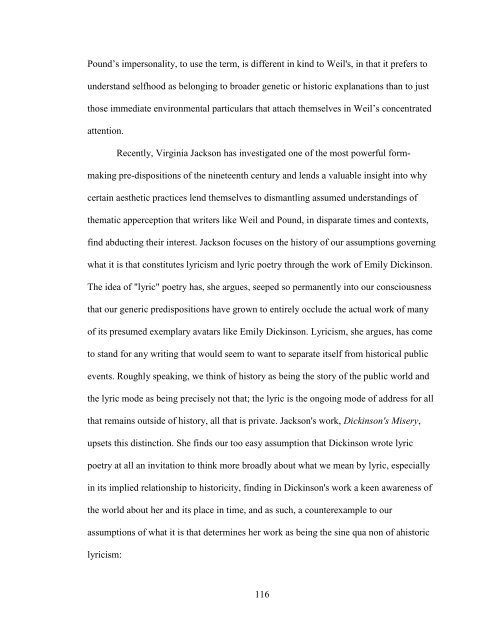TABOO: THE ACTUAL MODERNIST AESTHETIC, MADE REAL A ...
TABOO: THE ACTUAL MODERNIST AESTHETIC, MADE REAL A ...
TABOO: THE ACTUAL MODERNIST AESTHETIC, MADE REAL A ...
Create successful ePaper yourself
Turn your PDF publications into a flip-book with our unique Google optimized e-Paper software.
Pound‘s impersonality, to use the term, is different in kind to Weil's, in that it prefers to<br />
understand selfhood as belonging to broader genetic or historic explanations than to just<br />
those immediate environmental particulars that attach themselves in Weil‘s concentrated<br />
attention.<br />
Recently, Virginia Jackson has investigated one of the most powerful form-<br />
making pre-dispositions of the nineteenth century and lends a valuable insight into why<br />
certain aesthetic practices lend themselves to dismantling assumed understandings of<br />
thematic apperception that writers like Weil and Pound, in disparate times and contexts,<br />
find abducting their interest. Jackson focuses on the history of our assumptions governing<br />
what it is that constitutes lyricism and lyric poetry through the work of Emily Dickinson.<br />
The idea of "lyric" poetry has, she argues, seeped so permanently into our consciousness<br />
that our generic predispositions have grown to entirely occlude the actual work of many<br />
of its presumed exemplary avatars like Emily Dickinson. Lyricism, she argues, has come<br />
to stand for any writing that would seem to want to separate itself from historical public<br />
events. Roughly speaking, we think of history as being the story of the public world and<br />
the lyric mode as being precisely not that; the lyric is the ongoing mode of address for all<br />
that remains outside of history, all that is private. Jackson's work, Dickinson's Misery,<br />
upsets this distinction. She finds our too easy assumption that Dickinson wrote lyric<br />
poetry at all an invitation to think more broadly about what we mean by lyric, especially<br />
in its implied relationship to historicity, finding in Dickinson's work a keen awareness of<br />
the world about her and its place in time, and as such, a counterexample to our<br />
assumptions of what it is that determines her work as being the sine qua non of ahistoric<br />
lyricism:<br />
116
















